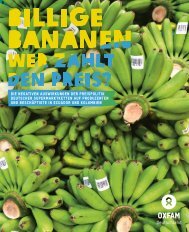228776e
228776e
228776e
Create successful ePaper yourself
Turn your PDF publications into a flip-book with our unique Google optimized e-Paper software.
and employ inverted commas in order to identify historical terminology, although T2 refers to<br />
the ‘final solution’, ‘crystal night’ and ‘living space’ without inverted commas. The moral bias<br />
varies from fatalistic, where authors refer to the event as a ‘critical moment’ (T2) or ‘moral<br />
crisis’ (T4), to progressive, where authors link the Holocaust to the post-war drive to prevent<br />
crimes against humanity, genocide and war (T3).<br />
Didactic approach<br />
All textbooks contain open enquiry-based didactic exercises devoted to either source analysis<br />
(T2, T3 and T4), critical reflection (T2 and T3), the explanation of camps (T3, T4 and T5), or<br />
reflection on links between the Holocaust and present-day ‘ethnic cleansing’ (T1). More<br />
generally, the textbooks explicitly provoke reflection on the Holocaust in connection with<br />
mass violence and genocide generally, albeit without explaining these links. T1 asks pupils to<br />
investigate the significance of ‘ethnic cleansing’, T2 evokes the issue of Holocaust denial and<br />
provides a world map depicting the sites of genocides occurring in the twentieth century, T3<br />
addresses human rights and contains a box devoted to the creation of the United Nations and<br />
a section about the ‘moral impact’ of the Holocaust, while T2, T3 and T4 evoke the memory<br />
of the Holocaust generally.<br />
National idiosyncrasies<br />
A large proportion of the textbooks (T1, T4 and T5) used in Spain treat the Holocaust in the<br />
context of the Second World War and in text boxes which are distinct from the main textbook<br />
narrative. They refer to a complex array of meta-historical topics, including memory and the<br />
transmission of knowledge of the event via film, education, memorials and historiography.<br />
Links between the Holocaust and the Spanish Civil War are rare, and none raise the issue<br />
of the failure of the Allies to act in defence either of Republicans in 1937 or of victims of the<br />
Holocaust. T3 merely states that the German invasion of Spain served to ‘test weapons’ to be<br />
used later in the war, while T2 depicts Republican prisoners in Mauthausen making victory<br />
signs with their hands at the moment of their liberation.<br />
Bibliography<br />
T1: Cortés Salinas, C., Fernández-Mayorales Palomeque, J. 2011. Ciencias Sociales, Historia, Comunidad de Madrid<br />
4. Madrid, Equipo de Ediciones SM. (history, social sciences, in the series ‘Comunidad de Madrid’, age 16 years,<br />
in Spanish)<br />
T2: Redal, E. J. (director), Grence Ruiz, T., Álvarez, P. A., Rubalcaba, B. R., Caballero Martínez, J. M., de Torres-Peralta,<br />
O. E., Iniesta Ayerra, J., López Santana, T. and Medina Rodríguez, V. (contributors). 2008. Historia 4 ESO. Madrid,<br />
Santillana. (history, in the series ‘Proyecto La casa del saber’, age 16 years, in Spanish)<br />
T3: Garrido González, A. 2008. Ciencias Sociales. Historia. Barcelona, Grupo Edebé. (history and social sciences,<br />
age 16 years, in Spanish)<br />
T4: Burgos Alonso, M., Muñoz -Delgado y Mérida, M. 2011. Historia. Ciencias Sociales. Educación Secundaria 4. Madrid,<br />
Anaya. (history and social sciences, in the series ‘Ciencias Sociales, Geografía e Historia’, age 16 years, in Spanish)<br />
T5: García Sebastián, M and Gatell Arimont, C. 2009. Demos. Cinecias Sociales, Historia. Educación Secundaria. Cuarto<br />
Curso. Barcelona, Vicens Vives. (history and social sciences, age 16 years, in Spanish)<br />
144




